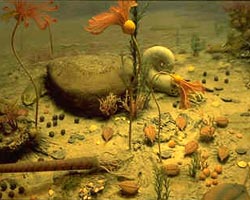Difference between revisions of "Paleozoic"
DavidB4-bot (Talk | contribs) (→top: clean up & uniformity) |
|||
| Line 20: | Line 20: | ||
According to the uniformitarian view, the Paleozoic started shortly after the breakup of a supercontinent called Pannotia and at the end of the era, the continents gathered together into a supercontinent called [[Pangea]] (approximately 300 million years ago). | According to the uniformitarian view, the Paleozoic started shortly after the breakup of a supercontinent called Pannotia and at the end of the era, the continents gathered together into a supercontinent called [[Pangea]] (approximately 300 million years ago). | ||
| − | {{QuoteBox|The Paleozoic is bracketed by two of the most important events in the history of animal life. At its beginning, multicelled animals underwent a dramatic "explosion" in diversity, and almost all living animal phyla appeared within a few millions of years. At the other end of the Paleozoic, the largest mass extinction in history wiped out approximately 90% of all marine animal species.<ref> [http://www.ucmp.berkeley.edu/paleozoic/paleozoic.html The Paleozoic Era 543 to 248 Million Years Ago]</ref>}} | + | {{QuoteBox|The Paleozoic is bracketed by two of the most important events in the history of animal life. At its beginning, multicelled animals underwent a dramatic "explosion" in diversity, and almost all living animal phyla appeared within a few millions of years. At the other end of the Paleozoic, the largest mass extinction in history wiped out approximately 90% of all marine animal species.<ref>[http://www.ucmp.berkeley.edu/paleozoic/paleozoic.html The Paleozoic Era 543 to 248 Million Years Ago]</ref>}} |
== External links == | == External links == | ||
Revision as of 17:10, July 13, 2016
The Paleozoic or Palaeozoic era is the earliest of three geologic eras of the Phanerozoic eon in the Geologic system of classifying rocks.
The Paleozoic era is divided into six different periods:
The Paleozoic was originally known as the Primary, but was renamed the Paleozoic, meaning ancient life, according to the evolutionary view. Under the uniformitarian dates assigned by secular geologists, it represents approximately the period of Earth's history from 540 million years ago to 250 million years ago.[1]
Flood geologists reject the uniformitarian assumptions behind the dates derived by secular geologists, so they reject these dates (see geologic system). Instead, they would consider the Paleozoic sediment to be early Flood deposits.[2]
According to the uniformitarian view, the Paleozoic started shortly after the breakup of a supercontinent called Pannotia and at the end of the era, the continents gathered together into a supercontinent called Pangea (approximately 300 million years ago).
The Paleozoic is bracketed by two of the most important events in the history of animal life. At its beginning, multicelled animals underwent a dramatic "explosion" in diversity, and almost all living animal phyla appeared within a few millions of years. At the other end of the Paleozoic, the largest mass extinction in history wiped out approximately 90% of all marine animal species.[3]
External links
References
- ↑ Gradstein, F.M., and Ogg, J.G.,Geologic Time Scale 2004 – Why, How, and Where Next!
- ↑ Snelling, Andrew, Radiohalos in Granite, chapter 5 of DeYoung, Don, "Thousands, Not Billions", Master Books, 2005, p.89, ISBN 0-89051-441-0.
- ↑ The Paleozoic Era 543 to 248 Million Years Ago
